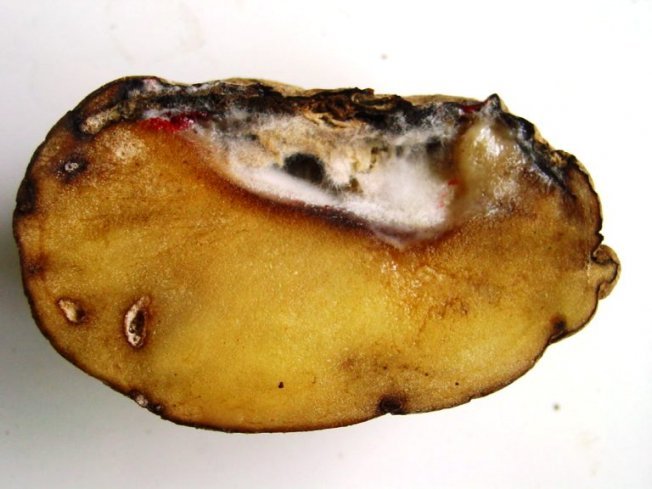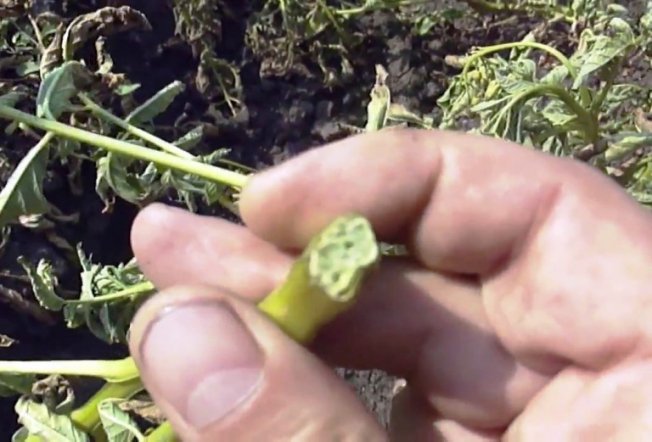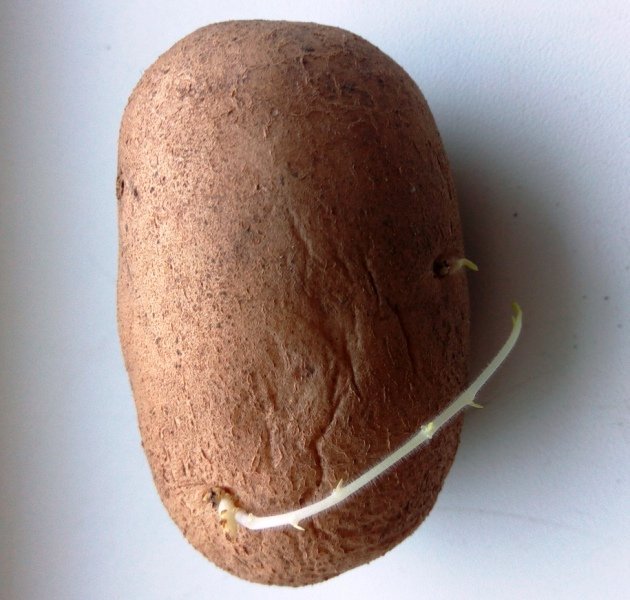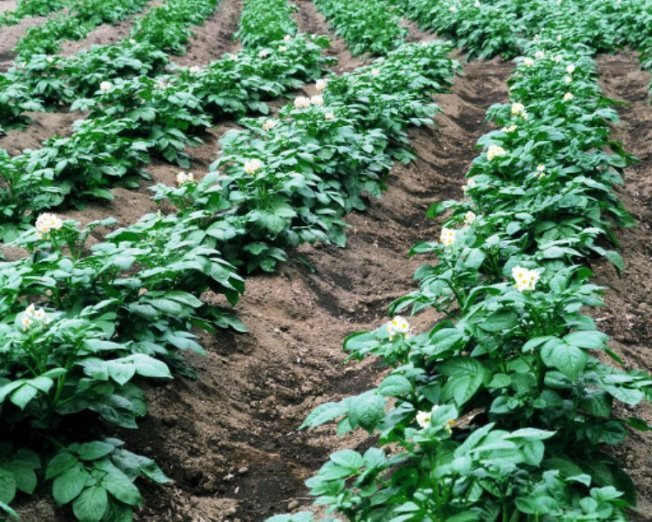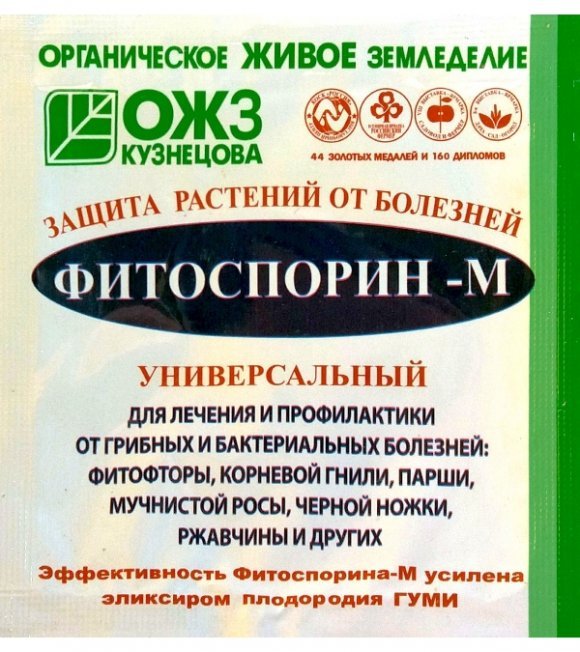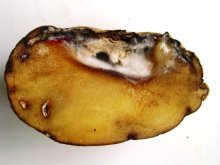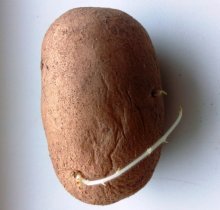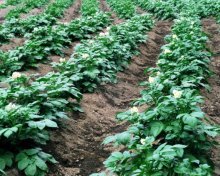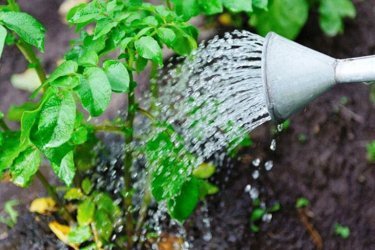Fusarium, or dry rot of potatoes, sources of infection, symptoms, treatment and preventive measures
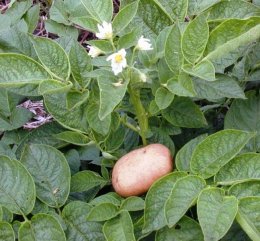
Fusarium is a fungal disease that has a detrimental effect on potato bushes during the growing season and on tubers during storage. Since actual crop losses can be up to 40%, it is important for vegetable growers to learn about the causes of dry rot and become familiar with modern methods of combating the dangerous disease.
Content:
- Factors provoking the development of the disease
- The causative agent of the disease, routes of infection
- Hidden and obvious signs of fusarium on potato stems and tubers, description and photo
- Consequences
- Treatment and prevention of fusarium
The causative agent of the disease, routes of infection
Fusarium wilt, or dry rot of potatoes, is a fungal disease. Its causative agent is Fusarium oxysporum.
The disease is widespread in the Far East, in the southeastern regions of the Russian Federation.
Sources of Fusarium infection can be:
- Fusarium oxysporum spores on the remains of other plants in the soil;
- infected organic fertilizers applied to the soil;
- planting material affected by fungus.
The main source of infection is infected soil, in which the mycelium of the fungus tends to persist for several (about 5-6) years.The fungus penetrates through the plant's horse system, then the mycelium develops in the conducting system, which leads to blockage of blood vessels. The transition of the disease to the active stage occurs during the flowering period, when the potato immune system is most vulnerable.
Infection during storage occurs:
- due to the presence in storage areas of organic residues from the previous year’s harvest, or contaminated soil;
- when selecting for storage tubers affected by fungus or having mechanical damage.
Before planting a new crop, it is recommended that the place intended for storing potatoes be thoroughly cleaned, dried and ventilated, and treated with a fungicide solution.
During storage, it is advisable to periodically sort through the potatoes; it is very important to exclude the possibility of infection of healthy tubers from already diseased ones.
Factors provoking the development of the disease
Plant damage occurs due to a combination of several factors:
- the presence of cuts on the tubers, holes eaten by mole crickets or wireworms, damage by nematodes;
- lack of proper care for the beds: they are not loosened, not weeded, and overgrown with weeds;
- excessive soil moisture at high ambient temperatures;
- applying excess amounts of nitrogen fertilizers;
- soil contamination with pathogenic microorganisms;
- planting potatoes in the same place more often than after 4 years.
During storage of tubers, the active development of fungi is caused by:
- the air temperature in the storage is above +12 C (the optimal indicator is below + 12 C);
- air humidity exceeding 90%;
- temperature fluctuations causing condensation.
If stored improperly, losses can reach 15%.
Hidden and obvious signs of fusarium on potato stems and tubers, description and photo
The plant can be affected by fusarium at any stage of development. The lesion is focal in nature, this is especially noticeable in the midday heat.
Most often, the first symptoms appear during the flowering period: the shade of the leaves changes to lighter, then marginal anthocyanosis begins to develop. Next, the leaves wilt and droop. The color of the lower part of the stem becomes brown; if the air humidity is high, a light coating may appear on its surface, and putrefactive processes begin to develop.
It only takes a few days for the diseased plant to completely wither; dried stems are easily pulled out of the soil. When taking a cross section of the stem, it is easy to see the browning of individual vessels or the entire vascular ring.
The development of fusarium rot on tubers can also occur during storage. A couple of months after laying in the basement, but maybe earlier, dull, grayish-brown spots-dents appear on the surface of the potatoes.
The potato pulp under the spots becomes dry, and voids are formed filled with whitish mycelium of the pathogenic fungus.
The development of pathogen spores on the surface of potatoes appears in the form of yellow, pinkish or white bulges.
Germination of affected potatoes occurs more slowly than healthy ones; the sprouts are thread-like and weak.
The danger lies in the very rapid spread of infection to nearby tubers.
Fusarium, what it looks like, what symptoms can be used to determine the onset of the disease, watch an interesting video:
Consequences
Untimely diagnosed and untreated fusarium can have disastrous consequences. Under favorable weather conditions, it can lead to a loss of 40% of the crop.
The course of the disease is quite rapid, its manifestations can be observed in the early period, in the form of:
- thinning of seedlings,
- severe slowdown in plant development and growth.
Infected tubers are more often affected by gray rot.
Treatment and prevention of fusarium
Measures used to combat fusarium can be divided into two groups:
- Biological.
- Agrotechnical.
Agrotechnical ones include:
- maintaining moderate humidity in potato beds;
- thorough weeding and weed removal;
- tracking and removing diseased bushes and then burning them;
- mandatory compliance with crop rotation;
- timely preventive treatment of bushes during the growing season;
- avoiding injury to tubers during harvesting, transportation, and storage;
- use only healthy tubers for planting;
- placing beds in non-wetland areas with light soils;
- introducing complex mineral fertilizers into the soil, in particular those containing potassium, which increases the resistance of plants to fungal infections;
- combating late blight, treating plants with fungicides during the growing season reduces the threat of tubers being damaged by dry rot during storage;
- planting varieties with increased resistance to the disease (Detskoselsky, Priekulsky, Berlichingen)
Biological impact involves the use of chemical and biological agents that can destroy fusarium pathogens.
Fungicides used to treat plants act on the lesions from the inside. Such drugs contain beneficial microorganisms that can cause the death of pathogenic cells. They are considered safe for humans.
The most popular biological drugs:
- Baktofit;
- Fitosporin-M;
- Integral.
Treating seed potatoes with contact action agent MAXIM.KS gives a good effect:
before storing;
before planting in the beds.
Before storing, the tubers are dried in dark, cool rooms for at least two weeks and carefully sorted.
Let's watch an interesting video about the prevention and treatment of potato diseases:
Fusarium, or dry rot, is a common disease that can lead to the death of a significant part of the crop. Compliance with agricultural practices and crop storage rules will help reduce the risk of its occurrence.

